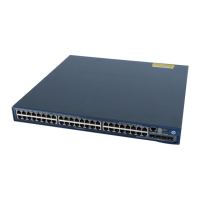87
port-group manual port-
group-name
Enable the root guard function for the port(s)
Required
Disabled by default.
NOTE:
Among loop guard, root guard and edge port settings, only one function (whichever is configured the
earliest) can at a time take effect on a port.
Enabling loop guard
By continuing to receive BPDUs from the upstream device, a device can maintain the state of the root port
and blocked ports. However, because of link congestion or unidirectional link failures, these ports might
fail to receive BPDUs from the upstream devices. The device will reselect the port roles: Those ports in
forwarding state that failed to receive upstream BPDUs will become designated ports, and the blocked
ports will transition to the forwarding state, resulting in loops in the switched network. The loop guard
function can suppress the occurrence of such loops.
The initial state of a loop guard-enabled port is discarding in every MSTI. When the port receives BPDUs,
its state transitions normally. Otherwise, it stays in the discarding state to prevent temporary loops.
Make this configuration on the root port and alternate ports of a device.
Follow these steps to enable loop guard:
Enter interface
view or port
group view
Enter Ethernet interface view
or Layer 2 aggregate
interface view
interface interface-type
interface-number
Required
Use either command.
port-group manual port-
group-name
Enable the loop guard function for the ports
Required
Disabled by default.
NOTE:
Do not enable loop guard on a port that connects user terminals. Otherwise, the port will stay in the discarding
state in all MSTIs because it cannot receive BPDUs.
Among loop guard, root guard and edge port settings, only one function (whichever is configured the earliest)
can at a time take effect on a port.
Enabling TC-BPDU guard
When a switch receives topology change (TC) BPDUs (the BPDUs that notify devices of topology
changes), the switch flushes its forwarding address entries. If someone forges TC-BPDUs to attack the
switch, the switch will receive a large number of TC-BPDUs within a short time and be busy with
forwarding address entry flushing. This affects network stability.

